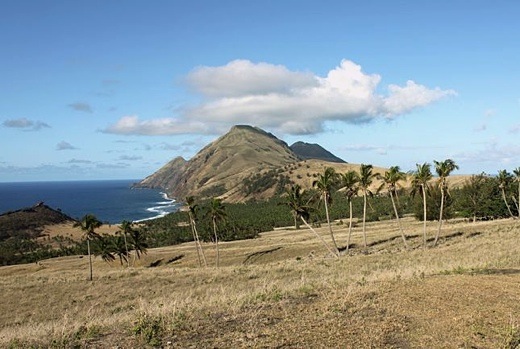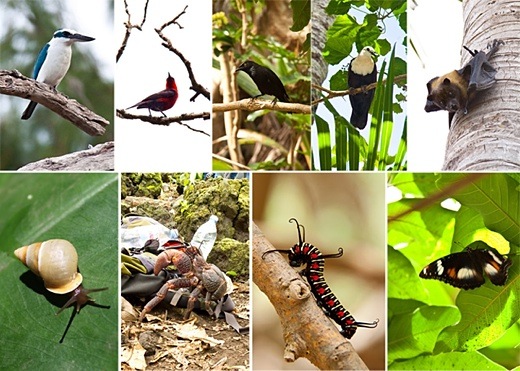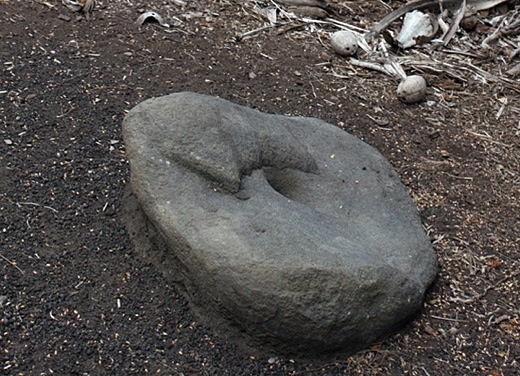SOURCE: Koohan Paik (koohanpaik@gmail.com)
SUBHEAD: A tropical island too beautiful to bomb is to be the target of US Navy munitions.
By Michael Hadfield on 16 September 2013 for Sierra Club -
(http://sierraclub.typepad.com/planet/2013/09/pagan-island-too-beautiful-to-bomb.html)

Image above: A view across Pagan Island as it looks today. Navy plans to use the island for bombing practice; likely with depleted uranium munitions. From original article.
[Publisher's note: For backgroundon US Navy plans for destroying Pagan Island see Ea O Ka Aina: Navy to Conquer Marianas Again 7/8/13]
Pagan Island, one of a string of volcanic islands that make up the Commonwealth of the Northern Marianas (CNMI), is an ancient home to the Chamorro people and the habitat of unique animals and plants, many of them endemic, rare and endangered. Those natural and cultural resources are being put at risk by a plan by the U.S. Marines to use the island as a live-fire training ground. In scoping documents related to the environmental impact statement required for that plan to go forward, the Marines have characterized Pagan Island as being "desolate and uninhabitable." Photographs included below show how untrue this is.
Under a contract with the U.S. Fish and Wildlife Service, Sierra Club member Mike Hadfield of the University of Hawaii and his research team spent two weeks on Pagan Island, traversing it and cataloging biological resources found there.
Team members saw firsthand what is at stake and are working with residents of the Northern Mariana Islands to engage other individuals and organizations, including the Sierra Club, in the struggle to save Pagan Island.
That's Mike Hadfield, at left below, with other Save Pagan Island activists, including (back row) Bjorn Erickson, Steve Miller, David Hopper, and David Sischo, and (front row) Sheila Conant, Kevin Hall, and Jennifer Saufler.

Image above: clockwise from top left: native Collared Kingfisher; native Micronesian Honeyeater; native Micronesian Starling; native White-Throated Ground Dove; endemic Marianas Fruit Bat (globally endangered); native butterfly; native caterpillar; native coconut crab (threatened); endemic Marianas Tree snail.
Pagan Island has been inhabited by Chamorro people for more than 2,000 years, as attested by remains of ancient villages. It continues to be the home of a small population of Chamorros, and many more want to return to their ancestral homelands. Recent articles from Marianas newspapers, which can be found on the Save Pagan Island website, tell of the connection many people feel with Pagan and other northern islands and their desire to return to them.
SUBHEAD: A tropical island too beautiful to bomb is to be the target of US Navy munitions.
By Michael Hadfield on 16 September 2013 for Sierra Club -
(http://sierraclub.typepad.com/planet/2013/09/pagan-island-too-beautiful-to-bomb.html)

Image above: A view across Pagan Island as it looks today. Navy plans to use the island for bombing practice; likely with depleted uranium munitions. From original article.
[Publisher's note: For backgroundon US Navy plans for destroying Pagan Island see Ea O Ka Aina: Navy to Conquer Marianas Again 7/8/13]
Pagan Island, one of a string of volcanic islands that make up the Commonwealth of the Northern Marianas (CNMI), is an ancient home to the Chamorro people and the habitat of unique animals and plants, many of them endemic, rare and endangered. Those natural and cultural resources are being put at risk by a plan by the U.S. Marines to use the island as a live-fire training ground. In scoping documents related to the environmental impact statement required for that plan to go forward, the Marines have characterized Pagan Island as being "desolate and uninhabitable." Photographs included below show how untrue this is.
Under a contract with the U.S. Fish and Wildlife Service, Sierra Club member Mike Hadfield of the University of Hawaii and his research team spent two weeks on Pagan Island, traversing it and cataloging biological resources found there.
Team members saw firsthand what is at stake and are working with residents of the Northern Mariana Islands to engage other individuals and organizations, including the Sierra Club, in the struggle to save Pagan Island.
That's Mike Hadfield, at left below, with other Save Pagan Island activists, including (back row) Bjorn Erickson, Steve Miller, David Hopper, and David Sischo, and (front row) Sheila Conant, Kevin Hall, and Jennifer Saufler.

Image above: clockwise from top left: native Collared Kingfisher; native Micronesian Honeyeater; native Micronesian Starling; native White-Throated Ground Dove; endemic Marianas Fruit Bat (globally endangered); native butterfly; native caterpillar; native coconut crab (threatened); endemic Marianas Tree snail.
Pagan Island has been inhabited by Chamorro people for more than 2,000 years, as attested by remains of ancient villages. It continues to be the home of a small population of Chamorros, and many more want to return to their ancestral homelands. Recent articles from Marianas newspapers, which can be found on the Save Pagan Island website, tell of the connection many people feel with Pagan and other northern islands and their desire to return to them.
Pagan Island is beautiful and peaceful now, but it is at grave risk of being bombed, blasted, and shelled into a ruined and uninhabitable place if the U.S. military succeeds in turning it into a "target island" for live-fire training, as has happened in the past with other islands used for such purposes, including Vieques Island in Puerto Rico, Kaho'olawe Island in Hawai'i, and the Bikini, Enewetak, and Kwajelein Atolls in the Marshall Islands. Islands such as Diego Garcia, in the Indian Ocean, have simply been taken away from their native inhabitants and never returned to them.
The Save Pagan Island website (www.savepaganisland.org) provides a wealth of information on the history of the island, the U.S. Marines' plan for taking the island for live-fire training, the residents' reactions to those plans, plus more photos that illustrate the beauty of the island. The website is building a broad base of support for taking on the political forces supporting the U.S. military's plan.

Image above: an ancient grinding stone found near Dagusa Beach on the east side of Pagan Island.
Future steps in the struggle will include review of the environmental impact statement now being prepared by the U.S. Marine Corps for its planned uses of Pagan Island and other areas in the CNMI. The Sierra Club and other organizations with relevant expertise will be working with Save Pagan Island to review the EIS, make comments on it, and assure that the final EIS meets the legal requirements of the National Environmental Policy Act.
• By Michael Hadfield, Professor of Biology, University of Hawaii.
.
No comments :
Post a Comment